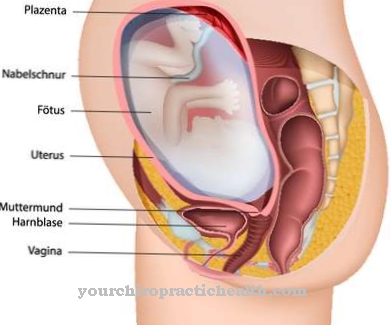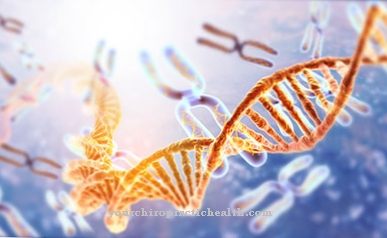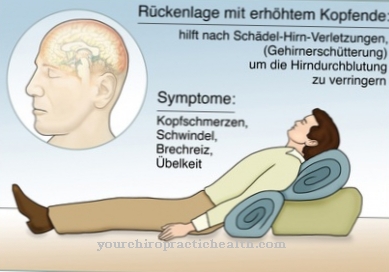The Down syndrom or Trisomy 21 is not a disease in the traditional sense. It is more likely to be viewed as a congenital chromosomal disorder or chromosomal change. Unfortunately, Down's syndrome can neither be prevented nor can this "disease" be cured. Those affected and their relatives must learn to live with trisomy 21. Nevertheless, one can help the affected people to make their life as natural as possible.
What is Down Syndrome (Trisomy 21)?
.jpg)
© nd3000 - stock.adobe.com
Down syndrome or trisomy 21 is a defect in the genetic material that results in intellectual disabilities of varying degrees. Accordingly, intellectual abilities are limited, which is evident, for example, from the delay in linguistic development and motor skills.
Visually, people with Down syndrome are characterized by a few features: They have a flat face, slanted eyes, small ears and broad hands with short fingers. This resulted in the original name "mongoloid", which is no longer used today.
People with Down syndrome are below average, with a tendency to become overweight after puberty. They are more prone to disease, especially those affecting the airways and ears. Very many have a heart defect. Down syndrome thus harbors a multitude of problems.
causes
The cause of Down's syndrome is almost always the triple presence of chromosome 21 in the cells. People with Down syndrome usually have 47 chromosomes instead of 46. A distinction is made between free trisomy 21, which is the most common cause, translocation trisomy 21 and mosaic trisomy. Free trisomy 21 occurs when either the egg cell or the sperm cell has an additional chromosome number 21.
Trisomy 21 occurs when the pair of chromosomes 21 is not separated when the egg or sperm cell is formed. There is no rule for this case, usually chance is decisive. However, trisomy 21 becomes more likely as the mother ages. In 40-year-old mothers, one child in 80 is affected. The younger the mother, the less likely Down syndrome is.
The rare translocation trisomy is when only parts of chromosome 21 are tripled. The additional chromosome part is attached to another chromosome. People who have such chromosome material live without health restrictions. However, if you wish to have children, this shift in the genetic makeup can be transmitted and then lead to Down's syndrome.
The so-called mosaic trisomy leads to fewer restrictions for those affected. The reason is that these people have cells with normal chromosome material as well as cells with 47 chromosomes.
Symptoms, ailments & signs
Down syndrome is associated with a wide variety of physical and cognitive symptoms. The physical symptoms show up immediately after birth, but can also be determined by prenatal tests. Prenatally, many of those affected already show features such as shortened thigh bones, a head that is too small, heart defects, occasionally an intestinal obstruction and the sandal furrow (distance between the big and adjacent toe).
The signs and symptoms of Down syndrome are numerous and varied. Typical characteristics are usually small ears and a flat face, broad hands and short fingers, small body size and obesity with the onset of puberty. In addition, many people suffer from muscle weakness, thyroid malfunction, visual disturbances and hearing loss.
A third fontanel can often be observed postnatally. In addition, the eyes are equipped with a fold of skin in the inner corner of the eye and are slightly almond-shaped. Muscle tension in people with Down syndrome is usually lower, which can lead to poorly mobile tongue, nasal breathing and suction problems.
The mental and motor development of those affected is impaired, albeit to different degrees. Intellectually, the degree of disability ranges from severe to hardly existent - depending on the support and the individual case. While people with Down syndrome can usually understand what is being said, their ability to articulate is often limited.
The ability to react is usually reduced, which is already evident in the first few years of life. Emotions can be expressed, but the expression itself can be less controlled. Life expectancy is slightly reduced due to the numerous possible complications. However, the symptoms of Down syndrome do not necessarily mean helplessness. Rather, many of those affected master an everyday life that gets by with little help.
course
People with Down syndrome usually have a number of congenital malformations, such as heart defects. In earlier times this meant that around three quarters of those affected died before puberty; up to 90 percent before the age of 25. The prognosis has since improved significantly.
With individual treatment of the malformations and targeted support, it is possible with Down syndrome to live to be older than 50. The medical development is particularly favorable for patients with a mosaic trisomy with a high proportion of healthy cells. However, only the side effects of Down syndrome can be treated.
When should you go to the doctor?
Children with Down syndrome always need medical attention and supervision. Parents of children with trisomy 21 should try to find support measures and psychological support at an early stage. A visit to the doctor is also recommended if there are any questions or questions about the disability.
Either the responsible doctor or the emergency number of the nearest ambulance can be contacted for this. The DS-InfoCenter provides affected parents with further options for medical and psychological advice. If any unusual symptoms or discomfort occur in connection with Down syndrome, a doctor should always be consulted.
Parents who notice hearing problems or frequent gastrointestinal infections in their child, for example, should definitely have this clarified. If signs of an underactive thyroid or a congenital heart defect are noticed, it is best to speak to the responsible doctor directly. In the event of joint complications such as knee or hip problems, sprains or fractures, the emergency medical service must be contacted. In later life, symptoms of Alzheimer's dementia sometimes show up - then also talk to a doctor.
Doctors & therapists in your area
Treatment & Therapy
Down syndrome itself is not curable or treatable and a more or less severe intellectual disability cannot be reversed. However, it is possible to support those affected individually and to give them the opportunity to develop personally. This happens, for example, in sheltered workshops, where skills are developed and existing talents are supported.
Affected people learn a lot about "normal" life through manual activity and emotional affection, can develop motor and mental skills and practice social skills. A good family environment is also beneficial for this. From a medical point of view, it is necessary to treat existing malformations (heart, digestion, etc.). Under favorable conditions, it is possible for people with Down syndrome to live almost independently.
Outlook & forecast
As a congenital genetic disorder, Down syndrome can neither be improved nor cured on its own. The mental development of the person concerned will indeed advance, but a person with Down syndrome will never be able to reach the level of their peers without trisomy 21 or develop the same skills. The physical anomalies associated with Down syndrome will also be with those affected for a lifetime.
This does not mean that people with Down syndrome cannot develop spiritually at all. With targeted and adapted mental and physical support, they can also develop according to their abilities and possibilities, learn skills, gain experience and learn, express emotions and integrate themselves into a handicapped-friendly everyday life.
Many people with Down syndrome take adult jobs that they can do if they can, some partner up and many make valuable friendships. The prospects for the development of a person with Down syndrome naturally depend heavily on the support that the environment can offer them.
Parents who learn to deal with a child with Down syndrome at an early age can have a massively beneficial effect on their child's development. Even in later adulthood, people with trisomy 21 need regular professional development of their abilities and, just like a healthy person, they have to practice and train them regularly.
You can do that yourself
In addition to the therapy methods that curb the negative effects of trisomy 21 on the body of those affected, there is a wide range of possibilities for those affected to improve their everyday life. This includes in particular their social environment.
In the early years of development, it is important to give children with Down syndrome adequate access to all the opportunities that their peers also have. Some tasks may need to be completed with assistance.
Regularly practicing language games and lip exercises (blowing soap bubbles, etc.) has a small advantage in later language development. Fine motor handicraft tasks with both hands promote a feeling for causal relationships and practice motor skills. Movement games for promoting gross motor skills should be carried out with those affected.
In later years, tasks become more relevant. People with trisomy 21 also want to do their part in society. They too grow up and develop interests and can learn things. Taking them seriously here and accompanying them helps them to feel good about life. Most people with Down syndrome are aware of their limitations. Communicating one's own possibilities and the things that the person concerned would like to tackle should definitely take place with the environment. In this way, paths can often be created that lead to success.
Otherwise, for the well-being of those affected, it is also necessary that they are treated like any other person outside of care and support measures.



.jpg)

.jpg)


















.jpg)



